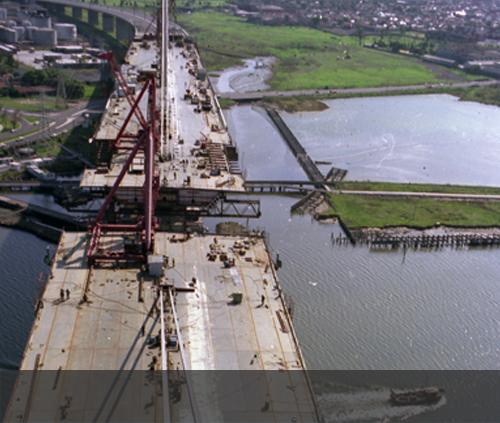When the two half girders on the west side, span 10-11, were brought into close proximity up on the structure, it was established beyond all doubt that a camber difference of about 4.5 inches (114mm) existed. It was proposed by JHC that time might be saved if the vertical difference of level could be taken out by using kentledge to push down the north half span relative to its south counterpart. It so happened that ten cube-shaped concrete blocks, each weighing about 8 tons, were on site from a previous operation, and it was thought that these would give about the right order of load to remove the camber difference, if positioned as a concentrated load near mid-span.
Jack Hindshaw, M.I.C.E, Resident Engineer, Freeman Fox and Partners for the project, discovered that the use of kentledge had caused a buckle to develop. His diary entry for Wednesday 9 September, 1970 includes the observation ‘Obvious overstress due to concrete kentledge.’
Neither in his diary nor elsewhere does Hindshaw comment that this unfortunate consequence was the result of JHC using more kentledge than the amount he had approved. There can be no doubt that the act of adding the kentledge was the precipitating cause of the buckle which appeared on the inner upper panel around joint 4-5 north. The buckle was a clear indication that partial failure of the structure had occurred.
On 2 June 1970, one span of the Milford Haven Bridge in Wales collapsed during construction. This bridge had many features in common with the West Gate Bridge including the use of a trapezoidal box girder. Following upon the Milford Haven collapse, certain steps were taken to strengthen the steel spans of the West Gate Bridge.
At the time that JHC took over Contract E, WSC had in fact, assembled the two half spans on the east side of the river between piers 14 and 15, and had successfully lifted them into position on top of the pier, but the joining of them, and the bolting together had not been completed, so that JHC had to complete the joining of those two half spans. On the west side there had been a certain amount of work done on the northern half span between piers 10 and 11, and at the time of the change-over, this partly assembled span was still on the ground.
Jacking up of this north half span between piers 10 and 11 commenced on the 15 May, 1970. After delays caused by strikes and bad weather, the rolling beam level was reached by 9 June 1970 and on the 19 June, the rolling of the north half span across the rolling beam commenced. This operation was completed on the 22 June.
The jacking of the southern half span was commenced on the 17 August. Eleven days later, it had reached the rolling beam level. On the 29 August, it was rolled across, and that process was completed on 1 September.
By 15 October two half spans 14-15 had been joined on the east side. Cantilevering for the next span had reached box 12, where it rested temporarily on a trestle specially erected for that purpose mid-way between piers 11 and 12. On the west side, the two half spans 10-11 had both been elevated and were resting on the rolling beams. They had been brought to their positions, but the longitudinal jointing between the two halves was less than a third completed.

